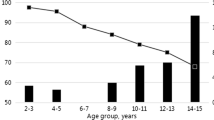Abstract
We evaluated the prevalence of hepatitis B virus (HBV) markers and established HBV vaccination status among 111 patients with hepatitis C virus (HCV) infection. A history of HBV immunisation was recorded in 30 patients (27.0%) and only 17/30 (66.7%) had anti-HBs level ≥10 mIU/ml. All patients were HBsAg-negative and 22.2% of nonvaccinated subjects had evidence of HBV infection as determined by anti-HBc presence. Among patients with anti-HBc in 7/18 cases (38.9%) anti-HBc was the only marker of HBV infection (without anti-HBs). The prevalence of anti-HBc was significantly higher among patients who reported a history of acute hepatitis. In conclusion the prevalence of HBV markers in patients with HCV infection in north-eastern Poland is similar to the prevalence in general population, which suggests no increased risk for nosocomial HBV infection among those individuals. HCV infection seems to favour unusual serological pattern of HBV infection with anti-HBc as the only marker. HBV vaccine use is low among patients with HCV infection in north-eastern Poland.
Similar content being viewed by others
References
Cacciola I, Pollicino T, Squadrito G, Cerenzia G, Orlando M, Raimondo G. Occult hepatitis B virus infection in patients with hepatitis C liver disease. N Engl J Med 1999; 34: 122–126.
Liaw YF, Chien RN, Lin SM, et al. Response of patients with dual hepatitis B virus and C virus infection to interferon therapy. Interferon Cytokine Res 1997; 17: 449–452.
Marusawa H, Osaki Y, Kimura T, et al. High prevalence of anti-hepatitis B virus serological markers in patients with hepatitis C virus related chronic liver disease in Japan. Gut 1999; 45: 284–288.
Zarski JP, Bohn B, Bastie A, et al. Characteristics of patients with dual infection by hepatitis B and C viruses. J Hepatol 1998; 28: 27–33.
Bielawski K, Wlasiuk M, Truskolawska M, Falkiewicz B. HCV infection in Poland. Arch Med Res 2000; 31: 532–535.
Juszczyk J, Gadysz A. Viral hepatitis in Poland. Hepatologia Polska 1997; 4: 65–70.
Magdzik W. Hepatitis B epidemiology in Poland, Central and Eastern Europe and the Newly Independent States. Vaccine 2000; 18: S13–S16.
Boroń P, Bobrowska E, Borzuchowska A, et al. Incidence of antigens and specific antibodies to hepatitis virus B in relation to other immunoserological markers in alcohol dependent subjects. Przeg Epid 1987; 41: 311–318.
Stążka J, Babiuch L, Musabbir M, et al. HBV, HCV, HDV infections among patients HIV +. Przeg Epid 1991; 45: 343–346.
Jilg W, Sieger E, Zachoval R, Schätzl H. Individuals with antibodies against hepatitis B core antigen as the only serological marker for hepatitis B infection: High percentage of carriers of hepatitis B and C virus. J Hepatol 1995; 23: 14–20.
Shih CM, Lo SJ, Miyamura T, Chen SY, Lee YH. Suppression of hepatitis B virus expression and replication by hepatitis C virus core protein in HuH-7 cells. J Virol 1993; 67: 5823–5832.
Author information
Authors and Affiliations
Rights and permissions
About this article
Cite this article
Chlabicz, S., Grzeszczuk, A. Prevalence of hepatitis B markers in patients with hepatitis C infection in north-eastern Poland: Risk factors and vaccine use. Eur J Epidemiol 17, 267–270 (2001). https://doi.org/10.1023/A:1017934410028
Issue Date:
DOI: https://doi.org/10.1023/A:1017934410028




